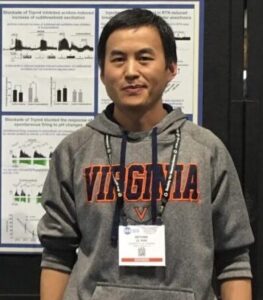People
Douglas A. Bayliss, Ph.D., PI
 Joseph & Frances Larner Chair and Professor of Pharmacology & Anesthesiology
Joseph & Frances Larner Chair and Professor of Pharmacology & Anesthesiology
Phone: (434)982-4449
Email: bayliss@virginia.edu
Serapio M Baca, Ph.D.
 Senior Research Scientist
Senior Research Scientist
Email: serapio.baca@virginia.edu
Phone: (434)982-4466
My research focuses on understanding the relationship, under various conditions, between respiratory centers in the brainstem that are chemosensitive (e.g., CO2 and pH) and those that are involved in driving inspiration and expiration. To understand these relationships requires a number of techniques including whole cell patch-clamp, nerve recordings, and optical imaging of populations of cells—neurons and glia—in reduced preparations. My approaches are complimented by a number of molecular approaches in the Bayliss lab that aim to uniquely identify the molecular components of the chemosensors and to identify cell-specific markers to better delineate the relevant cell networks present in the Retrotrapezoid nucleus (RTN) and other identified respiratory centers.
Keyong Li, Ph.D.
 Senior Research Scientist
Senior Research Scientist
Email: kl4jd@virginia.edu
Phone: 434-982-4466
I am interested in how ion channels contribute to the activity of brain cells and how that modifies the relevant behaviors in animal models, which may provide potential targets for the future treatments of channelopathies. My current studies focus on Retrotrapezoid Nucleus (RTN) neurons that sense CO2/H+ and control breathing. My recent work shows that TRPM4, a calcium-activated cationic channel, along with L-type calcium channels and various potassium channels (Kv and M channels), mediates a large subthreshold membrane potential oscillation that drives RTN neuron activity and breathing in mice (Cell Reports: 108714, 2021). I am currently investigating: ① the contribution of astrocytes in RTN to CO2-induced breathing in mice; and ② an RTN neuronal potassium channel that may be downstream of GPR4, which acts together with TASK-2 channels to sense CO2/H+. I use multiple tools for these studies, including patch clamp electrophysiology, qPCR, molecular histochemistry, imaging, viral-mediated gene expression injection and plethysmography in genetic mouse models.
Yingtang Shi, Ph.D.
 Assistant Professor of Research
Assistant Professor of Research
Email: ys6c@virginia.edu
Phone: (434)982-4466
I am interested in understanding the cellular and molecular mechanisms controlling the retrotrapezoid nucleus (RTN), a key brainstem chemoreceptor region that controls breathing. In my earlier work, I focused on identifying ion channels and receptors that contribute to regulating the firing activity and CO2/pH sensitivity of RTN neurons and CO2-regulated breathing (e.g., NALCN, TASK-2, GPR4). Later, I used single cell RNA-seq to characterize the expression profile for RTN neurons. This led directly to the discovery of Neuromedin B as a highly specific marker for RTN neurons. More recently, I found a striking birth-related upregulation of the peptide PACAP in mouse RTN neurons, and demonstrated that this neuropeptide and its related circuit stimulates breathing and protects neonatal mice from breathing disturbances. I am currently characterizing the roles of other neuropeptides and transcription factors in regulating RTN neuronal activity and their relevance to central respiratory diseases.
